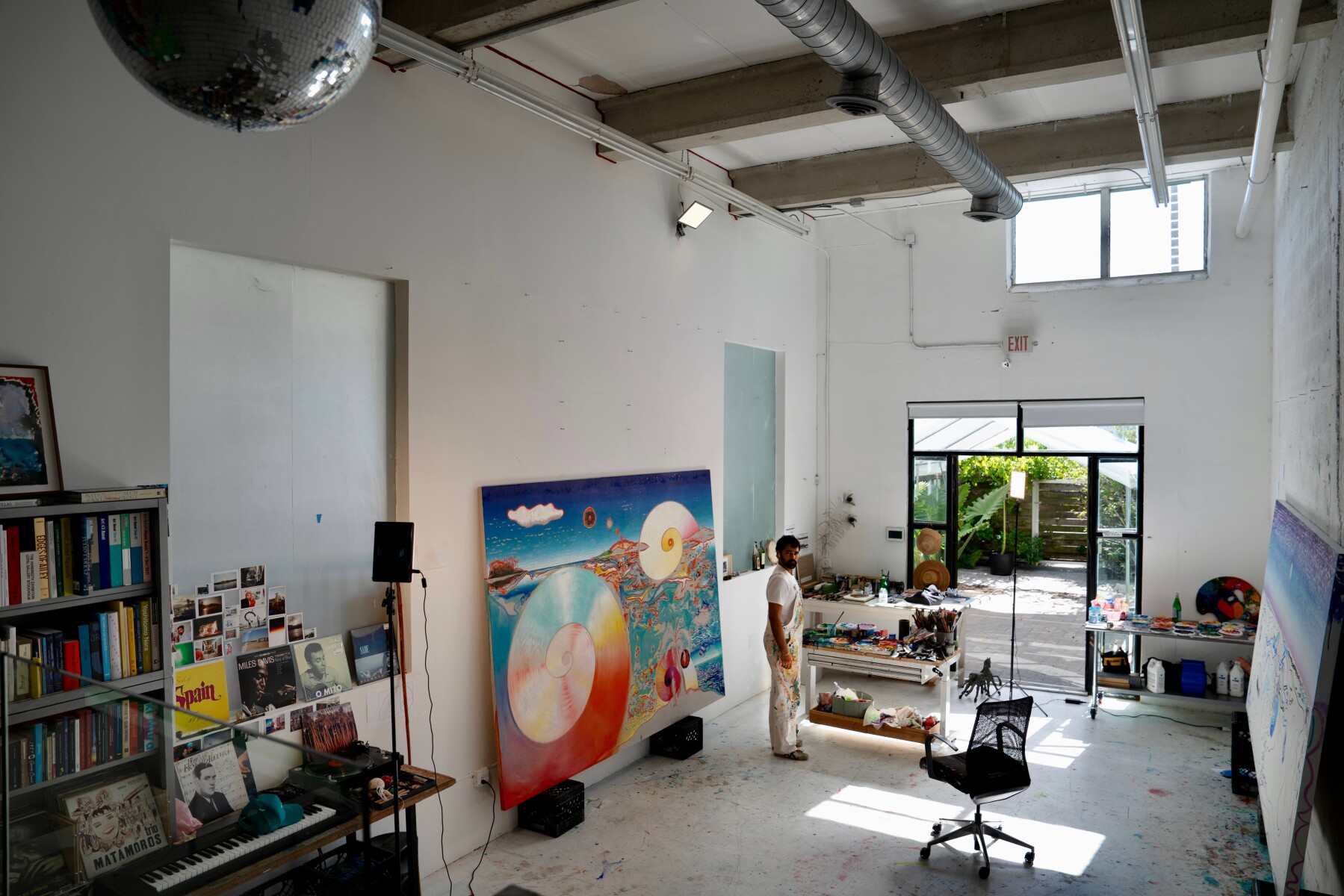Cultivist Conversations with Alejandro Piñeiro Bello
31 Oct 2025Alejandro Piñeiro Bello (b. Havana, 1990) is an artist whose work navigates memory, identity, and the enduring spirit of the Caribbean. Drawing inspiration from the landscapes, flora, and fauna of his Cuban homeland, as well as the urban and coastal environments of Los Angeles and Miami, he creates richly layered compositions that explore social, cultural, and mythical histories.
His practice is informed by Cuban poets and philosophers, and his visual language resonates with artists such as Wifredo Lam and Manuel Mendive, while also nodding to figures like Gauguin and Van Gogh. Working primarily in oil on raw linen, burlap, or hemp, Piñeiro Bello uses saturated hues and luminous accents to build depth and texture, evoking dreamlike, timeless landscapes that seem to hover between the real and the imagined.
Earlier this year, Club members had the rare opportunity to tour his private studio and witness his creative process firsthand. For those who couldn’t attend, our exclusive interview offers a closer look at Alejandro’s inspirations, his evolving practice, and life in Miami.
Q: Your work often draws on dreams and the subconscious. How do you translate those fleeting, intangible experiences into something tangible on the canvas?
A: My physical body has become this kind of instrument that allows me to extend my experiences, universal energies, and things I read, hear, see, and touch onto canvases. I am a chaos organizer. I see the world and filter information through the layers of my own experiences, dreams, and alternative realities, and these paintings are the product of living in acceptance and seeing everything as a creative possibility that allows me to change, mix, and reinvent physical matter and ideas.
Q: Many of your paintings feel deeply personal yet universally resonant. What core ideas or emotions do you hope to communicate to those who encounter your work?
A: Well, what is more universal than love, life, and death, day or night, air, music, wind, a spiral symbol drawing, a wave in the Caribbean, or the Arabian Sea? I have personal questions on matters like this that are the same philosophical questions another person will be wondering about on the other side of the world. Obviously, I play with images, objects, and landscapes living around me to organize my ideas and dreams. Still, the questions are the same fundamental questions of human existence: where do we come from, who are we, where are we going?
Q: How has your move to Miami influenced your artistic practice?
A: Sunshine! Miami sunshine hits differently than Cuban, Los Angeles, or NYC sunshine. In Cuba, sunshine is more orange-red, sometimes green, and the shadows are purple. In NYC, sunshine is crispy. In LA, it is perfect. Here in Miami, sunshine is quite a combination of all these other cities—it's more on the yellowy side of it—and I live on a little island that makes me very happy, always surrounded by water, like living in a Virgilio Piñera poem.
Q: Your use of raw materials such as linen, burlap and hemp adds an earthy, tactile quality to your work. What draws you to these surfaces, and how do they influence your process?
A: It comes from Arte Povera almost. Back in Cuba, I didn't have access to materials like here in the US. I had to invent my own surfaces to paint on. I would use anything I could get my hands on, like brown wrapping paper—like Wifredo Lam's "La Jungla" at MoMA. He made that on the cheapest brown wrapping paper because that's what you would find in Cuba. Canvases were very scarce, so you would discover alternatives like potato sacks made of burlap and use them as surfaces to paint on. I did a lot of paintings on paper, which led me to make thousands of watercolors. Then I started reinterpreting the technicalities of watercolor on paper onto burlap and linen. I used to steal my mom's bed sheets to paint on, and I used to make my own oil paint and charcoal from rose trees. All of this scarcity forced me to find new, simpler ways to create from an inferior position.
Q: If you could share a meal with any artist, poet, or historical figure, who would it be and what would you most want to discuss?
A: This changes with time, but at the moment, I would love to have a meal with the extraordinary Cuban painter Amelia Peláez. We would talk about everything about the beauty of the interior of a Cuban home in the 1940s—Amelia's world.
Q: Now that you’re based in Miami, where do you go to eat, drink, shop, see art, or simply recharge and absorb the city’s energy?
A: I love having lunch at Sur Empanadas. I go there almost every day. I'll recommend having your meal in the patio under the mango tree—I love it there. My favorites are KDR, Andrew Reed Gallery, and Central Fine. Some favorite museums are the ICA and the Rubell Museum, and Marquez Art Projects (MAP), and then my favorite thing in Miami is the beach!
Q: Are there any emerging artists or contemporaries whose work you’re currently excited about or feel a connection to?
A: I am very excited about the work of the extraordinary Kylie Manning at PACE.


